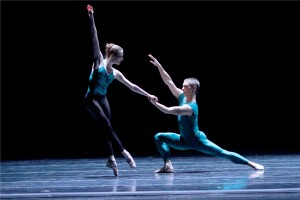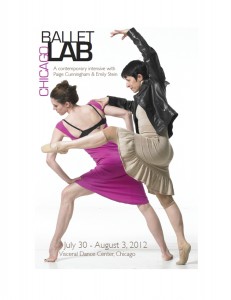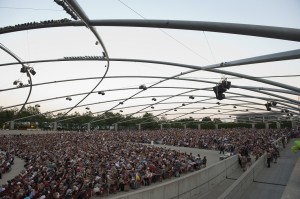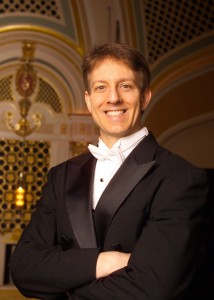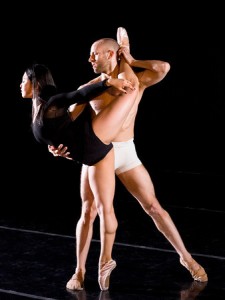“I love dance,” she said, eyes glistening with tears. Meet Lizzie MacKenzie – a petite, blonde whose energy and blue eyes light up the room. At 33 she has already lived lifetimes in the dance world. When she was 12, she joined a friend for “Bring a Friend to Dance Day” in Toronto, Ontario and was hooked. “It was immediate,” MacKenzie said. “I got to kick my legs and spin around the room. I didn’t know what I was doing, but I loved it. From the first class I took, I knew it was what I was going to do forever.”
Since that fateful day, she graduated from Interlochen Center for the Arts, danced on scholarship and as an apprentice for Giordano Jazz Dance Chicago (now Giordano Dance Chicago – GDC) before joining the company for five seasons, studied in New York City and Los Angeles, danced with River North Dance Chicago (RNDC) for six years. She started Extensions Dance Company while still dancing with RNDC and after “retiring” opened Extensions Dance Center. She is also on staff at Chicago High School for the Arts, Visceral Dance Studio and Steps Dance Center (Naperville), and choreographs and performs as a freelance/independent artist. If you’ve seen dance in Chicago in the last decade or so, you’ve seen her. And, if you have seen her, you won’t soon forget it. She radiates joy from the stage.
This Saturday, MacKenzie joins fellow Chicago dancers to perform in the 21st annual Dance For Life (DFL) at the Auditorium Theatre. Dance For Life is a benefit dance performance bringing together local companies and artists for a one-night-only show to raise funding for the AIDS Foundation of Chicago and the Dancer’s Fund. She’s performed in so many past DFL shows that she honestly can’t remember how many. We settled on at least ten, where she participated in the finale choreographed by Randy Duncan (and one by Harrison McEldowney). This year is no exception. MacKenzie dances in one of Duncan’s infamously difficult closing numbers and will be performing with Ron De Jesús Dance. RB met MacKenzie at her studio to discuss her career and this year’s show.
What brought you to Chicago?
Nan Giordano came to Interlochen and taught a Master Class. She offered me a scholarship for the school in Chicago. I told my parents that I wasn’t going to go to college. They were always good about that, but they told me if I was going to be a big girl, then I was going to be a big girl and they were cutting me off. ‘If you’re not going to do college, you’re going to support yourself.’ Literally two weeks out of high school I moved to Chicago. I went on scholarship at Giordano Dance Center, lived in somebody’s attic without a kitchen and worked two jobs. I wouldn’t recommend it, but it’s definitely helped form who I am. It worked for me.
Since you’re “retired”, how do you stay in fighting shape?
I use the term very loosely. I’m not retired, but I felt like it was time to retire from full-time work. Sustaining a relationship isn’t easy. (She’s newly engaged to chiropractor Michael Pontarelli – “Dr. Mike”.) Not that I have that much time now, but I have more. I’ve been freelancing. I’m dancing with Ron (de Jesús), dancing in the finale, in Wade Schaaf’s new company Chicago Repertory Ballet, I’m going to do some work with Ahmad (Simmons) and Brandon DiCriscio. I manage to fill my time up. I commit myself to two classes a week. I try for three. I try to get in whenever I can. I teach a lot.
You started the youth company while you were still in Rivno. Have you always wanted to have a company?
I definitely always wanted to have a youth company. If you’d asked me a few years ago, I would’ve told you that I wanted to have a dance studio. That changed when I was teaching so much and realized how much stuff comes along with that. So I started the youth company, because I left a studio and a couple of kids came with me and they wanted to perform. We needed a name and I said, “It has to be Extensions”, because that was what I was going to name my youth company, I just didn’t think it was going to happen now. I thought that would be when I was done dancing. It started out with four girls in 2005. I just started “Extensions Too!” And that’s for ages 8 to 11. That was a new experience this year. That’s why we opened the studio. It was just a natural progression. There was no way I could do the things I wanted to do. I was renting space. This is great – now I have constant access.
You have such a wonderful stage presence. How do you teach that – or can you?
I have a really genuine and innate love for the art form. I love what it has done for me. I feel it has really brought me out of my shell. I believe in dance as a means to communicate and movement as a means to communicate. I’d say some really important things I try to instill in the kids to help them understand that is the love of the art form and a really open state of mind. We work a lot on being open. We improv a lot. We do a lot of things that allow them to really open their minds and see more. Harriet Ross once told me that every time she saw me dance it seemed new. It always looks new. And it always feels new. Even today in ballet class, every thing feels new. It’s not just another plie to me. It’s the investigation. A simple plie to me is amazing. The body is so amazing and the possibilities are amazing. From feeling the air around my skin to seeing the space with my eyes or feeling my back…the investigation of movement is fascinating to me and brings me a lot of joy.
How is working with Ron?
I love being in process with him. This is my third time – once w/ GDC, but twice as an independent dancer and older artist. I love working with him. I feel like there’s a nice balance between him appreciating who I am or who each artist in the room is as an individual, but still having a clear enough vision of what he wants that he’s able to mix them nicely. He doesn’t down you if you make a choice that he wasn’t thinking. He’s able to appreciate your choices, but make sure you’re meeting his vision too.
The show itself is such a community effort. What’s dancing in the finale like?
It’s great. I’ve never felt any stress. This year is definitely my hardest. The finale might be the hardest thing I’ve done in my whole life. The thing is, when you go on stage for “Dance For Life”, it’s a different feeling. You know what the audience’s intention is for being there. Of course, you’re a little nervous because you put an expectation on yourself, but for some reason when you step on stage, you know that even if you mess up, it’s ok. When I’m on stage at “Dance For Life” I feel warm. I feel good. The process is always a little daunting, because it isn’t a lot of time.
I’ve heard many dancers over the years say that Randy’s finales are always the hardest things they’ve ever done. Why?
I think he really likes to challenge his dancers. He has a lot of respect for the dancers he chooses and he really likes to push them, particularly physically. It’s all in a deep, deep plié and a deep contraction. Honestly, you don’t a lot of work like that these days. And the cardio of it all, that’s the killer. I literally thought I was going to throw up.
What’s in your future?
It’s always worked out for me that my future becomes very clear as I continue on my path. Of course, I look back and think, I could’ve done this. But I’m happy with my path. There’s only “x” amount of years to live. You can’t do everything. I think I’m just going to keep doing what I’m doing. Hopefully things will continue to grow. I don’t want the youth company to get too much bigger. I think we’re able to produce the quality we have, because it’s small. The open classes have been going well. I’ll keep dancing until I can’t anymore. Maybe have a kid. I really want to have babies, so that will happen sooner or later.
Dance For Life at the Auditorium Theatre at Roosevelt Universtity, 50 E. Congress Pkwy. Saturday, August 18 at 8 pm. For ticket information, visit www.danceforlifechicago.com.


